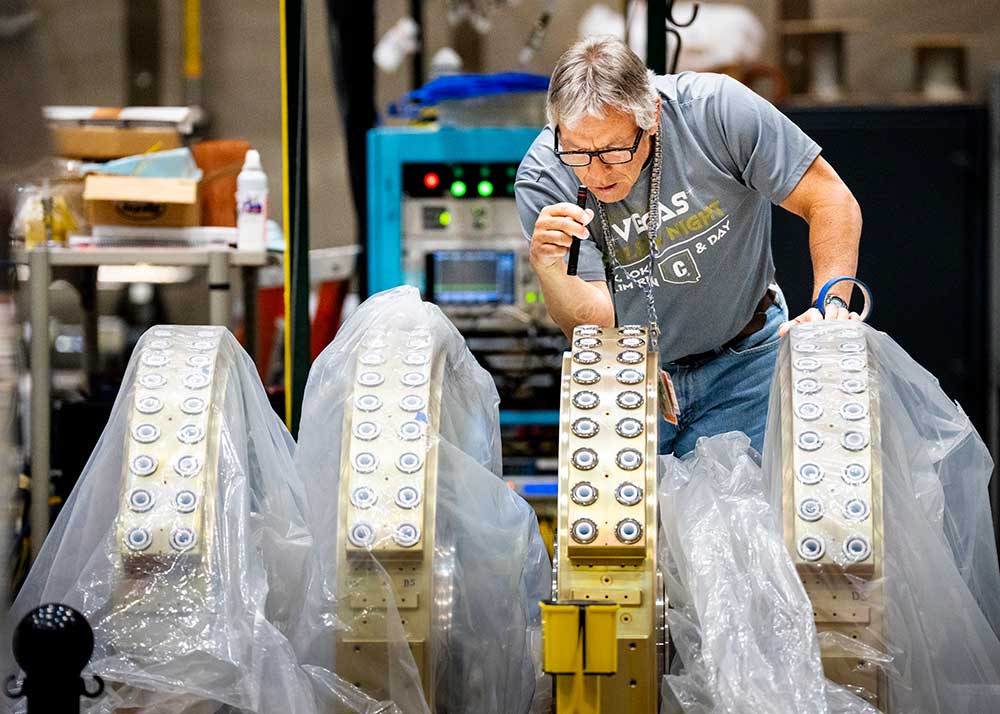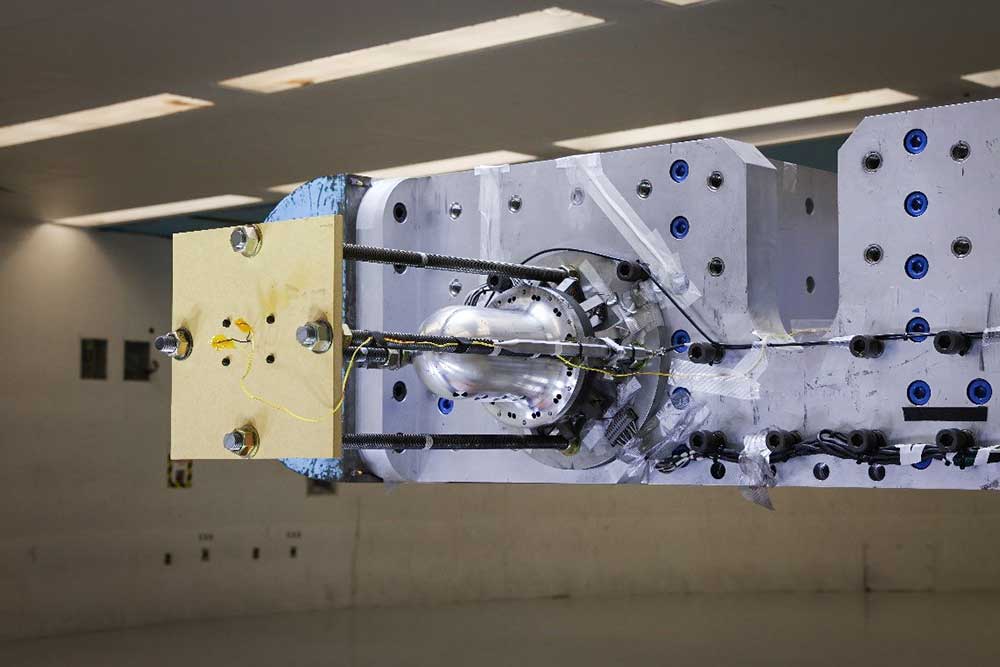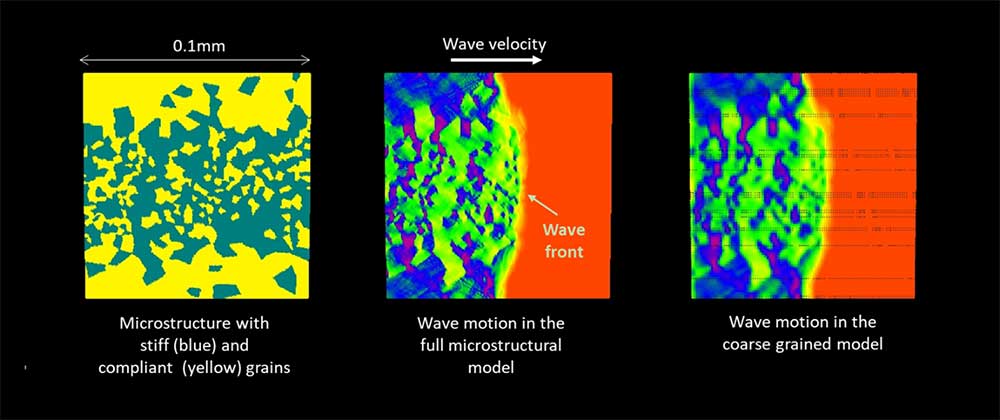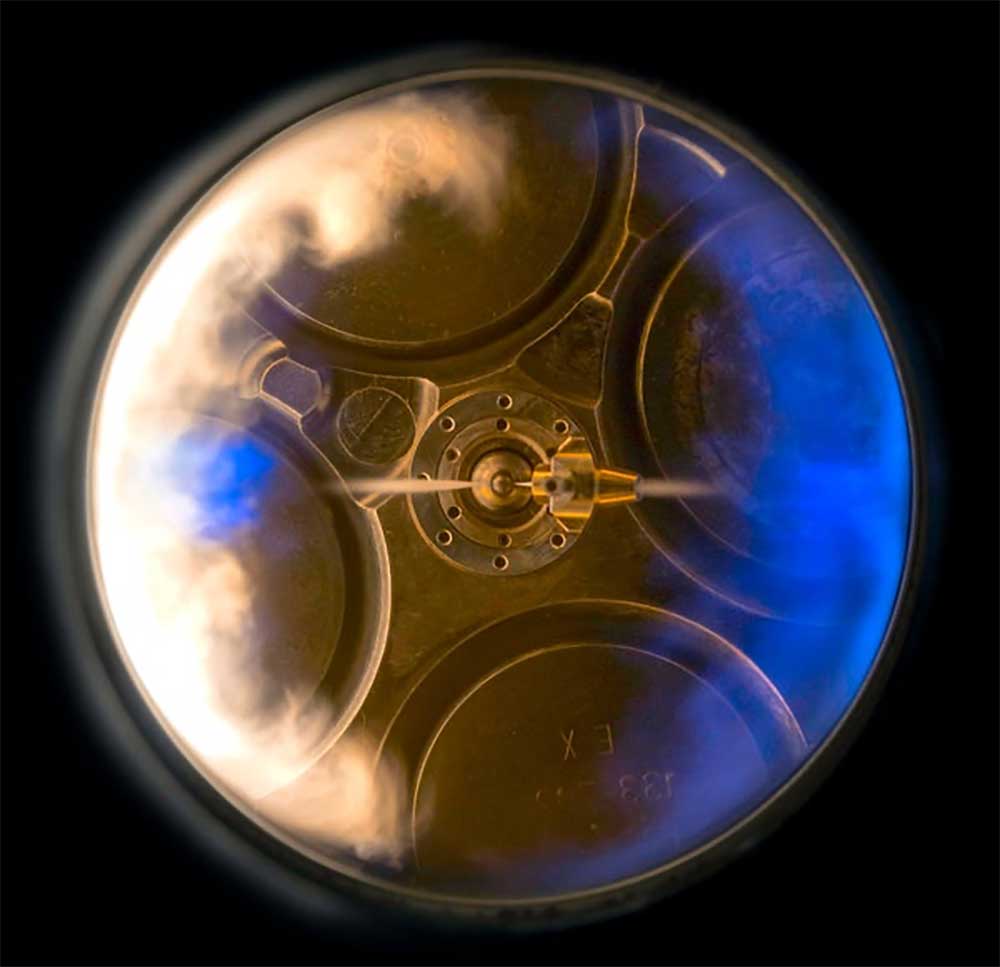
Sandia contributes component for subcritical experiments
The Advanced Sources and Detectors Scorpius project is a new radiography system being built at the Nevada National Security Site’s Principal Underground Laboratory for Subcritical Experimentation. The system will ensure the safety and reliability of nuclear weapons by capturing the final stages of weapon implosion. Sandia is providing the pulse injector for this program at the Integrated Test Stand at the Nevada site. Scorpius is a key part of the Enhanced Capabilities for Subcritical Experiments portfolio supporting stockpile stewardship. • 1000

Advancing wind tunnel technology
The Rapid Prototyping of the Wind Tunnel Models Demonstrator Project developed new hardware in Sandia’s hypersonic wind tunnel to demonstrate that 3D-printed models can effectively replace traditional machining methods. The project explored the complexity of shapes, surface quality, sensor integration, production time, overall cost and other aspects, and all results were positive, showing that this new approach allows faster production for quick testing and is significantly more affordable than traditional methods. • 1000

Cutting-edge testbed for AI workloads
Kingfisher was deployed at Sandia to expand research in artificial intelligence workloads for the Advanced Simulation and Computing program. Integrating this architecture enhances Sandia’s capabilities and lays the groundwork for pioneering advances in AI that will support DOE’s broader strategic objectives. Sandia has initiated several generative AI projects to develop science and engineering use cases in the national security domain, allowing researchers to evaluate training and fine-tune large multimodal models. • 1000
High Performance Software Foundation established
Sandia collaborated with Lawrence Livermore National Laboratory to lead the creation of the High Performance Software Foundation within the Linux Foundation. This new effort enhances performance portability and productivity for science and engineering software. The foundation unites leading high-performance computing institutions in government, academic and private sectors, resulting in increased support for vital high-performance computing software projects and greater promotion of collaborative development under open governance and community engagement. Sandia will continue to serve the foundation as a premier member, dedicating ongoing support for innovative software solutions in high-performance computing. • 1000, LLNL
Inaugural LDRD Mission Campaigns completed
Sandia completed two Laboratory Directed Research and Development Mission Campaigns: Resilient Agile Deterrence and Autonomy for Hypersonics. Resilient Agile Deterrence demonstrated such technical discoveries as interlocking metasurfaces for system architectures that now are maturing further and being qualifiied for consideration in future systems. Autonomy for Hypersonics has developed and demonstrated hardware and algorithms that enable more precise control of hypersonic vehicles while connecting universities that support the nation’s hypersonic needs. A4H identified post-mission campaign funding of over $40 million from
sponsors to continue the work. • 1000, 5000

Simulating realistic flight conditions
The shock-enabled superfuge Laboratory Directed Research and Development team developed a new capability that reproduces combined environment testing to replicate realistic flight conditions by heavily coupling modeling, simulation and testing. The team used Sandia’s modeling and simulation codes CTH, Zapotec and Sierra to rapidly design a resonant structure and explosive assembly tuned to deliver a specific combined environment into a nuclear component. This approach provides information under extreme conditions and valuable insights that help ensure the robustness and reliability of the nuclear deterrent. • 1000, 6000, 7000, 8000, LDRD
Rapid solutions for component design
While testing a component at the Annular Core Research Reactor and at White Sands Missile Range, SNL physicists and engineers developed a new method for collecting and analyzing data that allows a component owner to replicate issues, understand root causes, improve designs and qualify some components in just a few months. The updated component this team tested is now in production. • 1000
Leading in AI research and adoption
Sandia embraced AI by establishing an AI board of directors and a coordination office to streamline efforts and implement effective governance. The board defined strategic focus areas, aligning internal initiatives and enhancing collaboration among divisions. Sandia played key roles in the DOE Frontiers in AI for Science, Security and Technology initiative, interactions with Congress, leadership in the New Mexico AI Consortium and the inaugural AI Expo in Washington, D.C. • ESD, 1000, 5000, 8000, 9000

Novel algorithm for additively manufactured materials
Designing nuclear deterrence components with additively manufactured materials requires computational models that accurately account for the complex microstructures and spatially variable properties of these materials. Sandia has developed a coarse-graining algorithm that incorporates all relevant length scales in additive manufacturing metals, using a novel application of peridynamics, a theory of deformation and fracture of materials pioneered at the Labs. This new algorithm greatly improves computational efficiency compared to full, detailed microstructural models. This allows for the computer simulation of component-scale additive manufacturing structures while retaining important microstructural effects. • 1000
Improving gas analysis
The Gas and Engineering Laboratory successfully developed a new residual gas analysis for the Electrical Environmental Sensing Device/W80-4 Si-based microelectromechanical systems accelerometers. This two-year initiative involved adapting military standard techniques, collaborating with external vendors and qualifying the tool for in-house production. The analysis improved the microelectromechanical systems fabrication process before the final design review and allowed the Electrical Environmental Sensing Device team to successfully navigate a manufacturing shift without impact to schedule. The data was instrumental in recentering the fabrication process and ensuring reliability throughout the part’s lifetime. • 1000
4,000 shots on Z
On June 12, the Z machine achieved its 4,000th shot, marking a significant milestone since its conversion in 1996 from a particle beam fusion accelerator. In this past year, Z conducted experiments to advance several missions, including deuterium-tritium tests for inertial confinement fusion. Plutonium experiments, performed jointly with Los Alamos National Laboratory, supported multiple missions and gathered material physics data. Z validated System Generated ElectroMagnetic Pulse models, increased warm X-ray output and increased testing capabilities for radiation effects. Joint experiments with Los Alamos focused on opacity measurements and radiation flow. • 1000, LANL

Nuclear deflection of large asteroids
For the first time on Z machine, researchers have tested an idea that could protect Earth from catastrophic asteroid impacts. The experiment generated X-ray bursts that vaporized the surfaces of a miniature, mock asteroid, simulating a powerful nuclear explosion. The findings were scaled to demonstrate that kilometer-scale asteroids could be deflected. The experiments enable X-ray deflection tests for various asteroid materials in a lab. • 1000, 5000

Enhanced internship recruiting
In 2024, Sandia enhanced its student intern population through partnerships with historically Black colleges and universities that were established by the Academic Programs’ Securing Top Academic Research Talent HBCU Program, and by strengthening its talent pipeline strategy through NNSA’s Minority Serving Institute Partnership Program. In collaboration with Sandia’s Talent Acquisition team, the START HBCU program and Academic Programs coordination of MSIPP increased the numbers of interns hired at the Labs in 2024 to 69%. • 1000

Collaborative research reaches record levels
Cooperative Research and Development Agreements enable Sandia and its industrial partners to collaborate and share the results of jointly conducted research. They consider both parties’ needs and harness their distinct strengths to drive research and development, which ultimately pushes new technologies into the market. Sandia entered into 72 new agreements with the private sector and academia, a 93% increase from the average over the past 10 years and the most in a single year since 1994. • 1000

First phase of Saturn revamp completed
Major upgrades began for the Saturn accelerator, the world’s most powerful hot X-ray source for qualifying strategic weapon systems, after 35-plus years of operation. The refurbishment project is a cross-organizational effort led by the Advanced Science and Technology pulsed power community. Phase I, completed this year, focused on upgrades to facility infrastructure and the center of the machine, including the vacuum stack, magnetically insulated transmission lines and diode. The initial commissioning down-line shots indicate a stable center section and ease of operation. • 1000